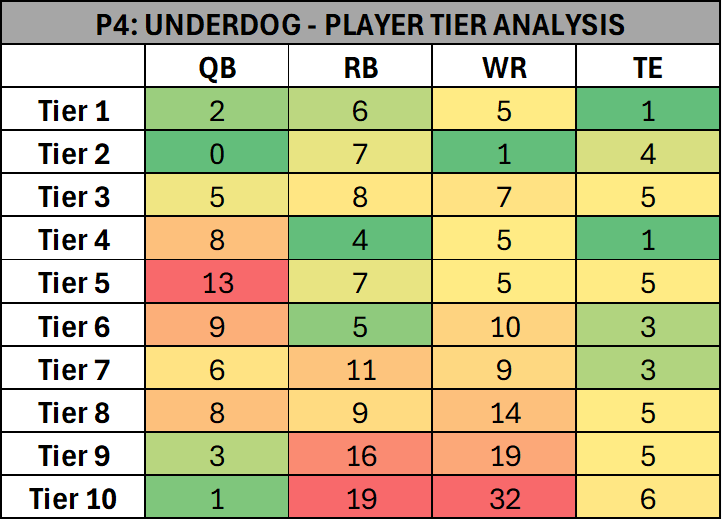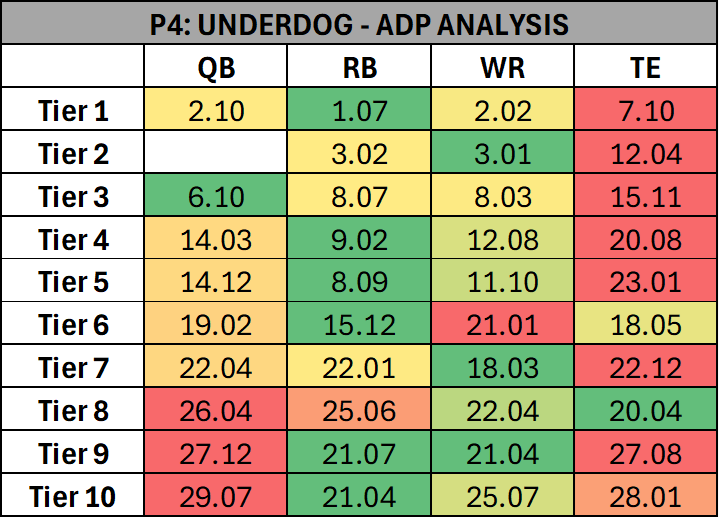Purple Reign must start by pointing out there is no “one way” to approach drafting a CFF team. This guide represents the strategy I have come up with after reviewing the 2025 player pool. You can follow this guide to the letter, or incorporate ideas into the draft strategy you already use. It is purely up to the reader how to use this information.
TIER ANALYSIS
I assign players into tiers based on several pieces of criteria. I start with the fantasy point projection I have made for the player within the specific scoring format. I then review the player’s position battle status and move players down the more uncertain that position battle status is. Then finally I review the profile I have assigned for that player. Players are moved down again based on the level of fantasy production potential.
Tiers go from 1 being the best, then counting their way downward. I consider all players from a position group in the same tier can be viewed as “equal” which allows a drafter to select the player that they like best.
Once I have finished my first round of player rankings I look at how many players from each position group are in each tier. This gives you a feel for how much depth, or lack thereof you can find at different position groups. Green represents rarity while red represents abundance. I’ve only included the top 10 tiers in this breakdown. This information will also help you determine which positions to focus on or wait for during the draft.
Quarterback: The top two tiers are very baren, meaning that you might want to try and snag one of the two tier 1 QBs. If you decide to pass on them then it’s a must that you draft one of the tier 3 players as your QB1. Tiers 4-8 provide the most abundance and this is a great place to start filling your bench. You’ll definitely want to take advantage of the tier 4-6 players before waiting to get your last QB from tiers 7-8.
Running Back: There is a good amount of players that can be obtained from tiers 1-3. Since tier 1 will be gone by the end of the first round its important to be aggressive in getting the tier 2-3 players while you can. Tiers 4-5 can be tapped into if you were being aggressive drafting players from other positions at high tiers. There’s a huge abundance of RBs starting in tier 7. You could afford to shift to drafting other positions while obtaining the occasional player from tiers 7-8. RB has the second highest amount of players in tiers 9-10, behind the WR position.
Wide Receiver: With only one WR in tier 2, it means you have to decide to reach for a tier 1 WR or wait for a tier 3 guy to be your WR1. If you wait you would want to hit up tiers 3-5 aggressively to fill out your starting line-up with these players. Since the abundance of WR options picks up starting in tier 6, you can afford to wait on WR at this point and prioritize other positions.
Tight End: It’s very important to land a TE in tiers 2-3 before the drop off occurs in tier 4. Once tier 5 comes up you could look at landing your TE2 there since tiers 6-7 don’t have many options available. By the time you’re down to tiers 8-10 you can afford to go after QBs before drafting guys in this range.
ADP ANALYSIS
Its extremely important to have an understanding of when players are being taken in drafts. ADP (Average Draft Position) is the tool used to assess this. I’ve pulled the ADP data from the end of June to use for this analysis. I’ve pulled the average ADP for all players within a tier for this review. Since I have players in tiers that are over-valued and under-valued, you will see players drafted earlier and later than these average numbers. The ADP data listed in this article is the average round & draft pick, with 1.01 presenting the first pic of the first round. Green represents the earliest average draft pick for a specific tier, while red represents the latest average draft pick. This ADP is from all FBS drafts which means players will be taken earlier than shown.
Quarterback: The biggest takeaway here is without a tier 2 QB, the tier 3 guys move off the board very quickly. You don’t want to miss on one of these guys and you should make this a major priority. Tiers 4-7 have lower ADP data which makes sense as drafters spread out when they’re drafting their reserve QBs.
Running Back: The tier 1 RBs will run out quickly in the first round, but after that the tier 2-3 players slide a bit as drafters chase QBs and WRs. Once that’s done and you get to tiers 4-6 the action picks up heavy against on RBs. These are the tiers you really need to focus on for building your RB roster depth.
Wide Receiver: The first two tiers will work their way through the first three rounds of the draft. After those players are gone there’s several rounds you can focus on other positions before pivoting back to the tier 3-5 WRs. Tiers 6-9 are all very bunched together in ADP and shows where the late WR run will occur.
Tight End: For the most part the TE position is an afterthought. They have the latest ADP numbers in six of the seven tiers. Tiers 5-8 appear to be where a late run occurs which you should be ready for.
CONCLUSION
Roster Breakdown: QB-5, RB-6, WR-6, TE-3
Rounds 1-2: 1 RB tier 1-3, 1 WR tier 1-2
Rounds 3-6: 2 QB tier 1-3, 2 RB tier 2-5
Rounds 7-10: 2 RB tier 3-5, 2 WR tier 3-5
Rounds 11-15: 1 QB tier 4+, 1 RB tier 4+, 1 WR tier 4+, 2 TE tier 2-3
Rounds 16-20: 2 QB, 2 WR, 1 TE (best available)







